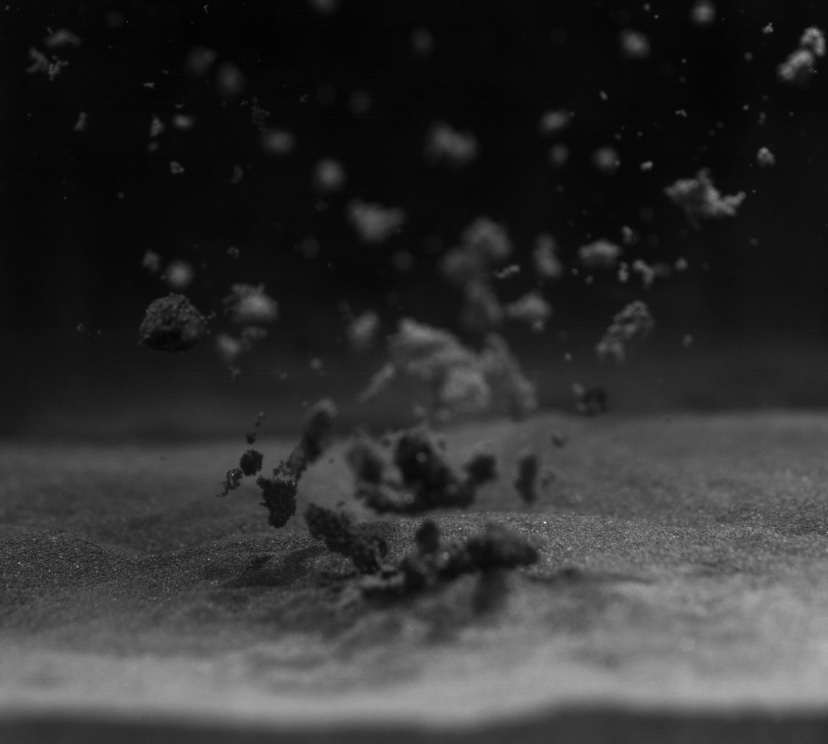Ejecta Generated by Ultra Slow Impacts on Regolith Surfaces in Low Gravity
- Experimental Astrophysics, Universität Duisburg-Essen, Duisburg, Germany (jonathan.kollmer@uni-due.de)
Rubble pile asteroids such as Itokawa, Ryugu, and Bennu are covered by regolith of various sizes. In some instances like on Itokawa the regolith is not distributed evenly but large boulders congregate in some areas whereas other are dominated by finer material [1]. Several mechanisms have been proposed to explain this size sorting, among them the so called ballistic sorting effect (BSE) [2]. The BSE depends on impacting particles rebounding more elastically from large targets (boulders) than when hitting a bed of fine grains. This mechanism of course not only applies to the primary impactor hitting an asteroid surface but also to secondary impacts from material ejected by the primary impact. In order to fully understand the BSE on asteroids, it is therefore important to quantify the mass- and velocity distribution of ejecta generated by impacts into asteroid surfaces. In particular from impacts with low velocities that will then generate ejecta that is slower than the escape velocity of the asteroid.
To conduct realistic experiments under asteroid conditions we use the ERICA (Experiments on Rebounding Impacts and Charging on Asteroids) platform [3] under the microgravity provided by the ZARM Bremen drop tower and the new GTB-Pro, also at ZARM. To provide a low but directed gravity level, i.e. asteroid gravity, ERICA consists of a vacuum chamber that contains the sample material which is mounted to a linear stage that - once the whole setup is in microgravity - provides a linear acceleration to simulate asteroid-level gravity. Using the linear stage eliminates any Coriolis forces a centrifuge would create. Due to the low g-jitter and the long microgravity time of 9.2 s in the drop tower and 2.5 s in the GTB-Pro these experiments are able to focus on ultra low velocity impacts in the cm/s rage, complementing earlier experiments by Brisset et al. [4].
In the sample chamber we place granular beds (regolith analog) of various sizes and a launcher mechanism that impacts a basaltic projectile at the simulated asteroid surface. Using a stereo pair of cameras, as well as a high speed camera we then record the ejecta plume created by the impact. From the resulting image data we extract ejecta velocities using particle tracking (for larger ejecta particles) and digital image correlation (for smaller ejecta).

Fig.1. Ejecta Plume generated by impacting a basaltic projectile (v = 65 cm/s) in a bed of 0-300 μm sized particles at a gravity level of 2 • 10-4 m/s^2
[1] A. Fujiwara, J. Kawaguchi, D.K. Yeomans, M. Abe, T. Mukai, T. Okada, J. Saito, H. Yano, M. Yoshikawa, D.J. Scheeres et al., Science 312,1330 (2006)
[2] T. Shinbrot, T. Sabuwala, T. Siu, M.V. Lazo,P. Chakraborty, Phys. Rev. Lett.118 (2017)
[3] K. Joeris, L. Schönau, L. Schmidt, M. Keulen, V. De-sai, P. Born, J. Kollmer, EPJ Web of Conferences 249, 13003 (2021)
[4] J. Brisset, C. Cox, S. Anderson, J. Hatchitt, A. Madison, M. Mendonca, A. Partida, D. Remie, Astron. Astrophys (2020)
How to cite: Joeris, K., Keulen, M., Schönau, L., and Kollmer, J. E.: Ejecta Generated by Ultra Slow Impacts on Regolith Surfaces in Low Gravity, Europlanet Science Congress 2022, Granada, Spain, 18–23 Sep 2022, EPSC2022-913, https://doi.org/10.5194/epsc2022-913, 2022.

